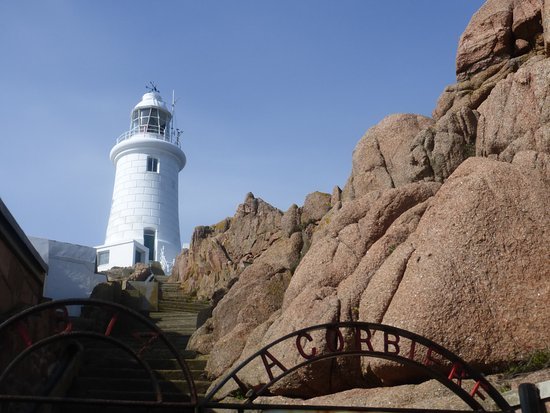12 fun and interesting facts about Jersey
Jersey is the largest of the seven Channel Islands and is just 9 miles long by 5 miles wide, but with a population of around 106,000
Until 1066 Jersey formed part of Normandy and paid its dues to the Abbey of Coutances. But in 1066 William the Duke of Normandy defeated Harold of England at the Battle of Hastings, and Normandy, including the Channel Islands became part of the English Crown. In 1204 when John 1 of England carelessly lost his lands in Normandy to Philippe of France the Channel Islands were given a choice between loyalty to the British Crown or to France. John offered the islands their independence. Remain loyal to Britain, and form the first line of defence against the French, and the islands could govern themselves, write their own laws, set their own taxes. France offered nothing, so the Channel Islands chose loyalty to the British crown.
Today the Channel Islands remain fiercely independent with their own governments. They are neither part of the United Kingdom nor the European Union but stand proudly apart.
Until 1901 however the island’s first language was French or Jersey French, and until very recently the Laws were still written in the French language. Even today Court sittings are commenced with an address in French.
1. Jersey wasn’t always know for it’s finance industry
Jersey and Guernsey have thriving finance industries, but in days gone past in Jersey agriculture, knitting, cider making, oyster farming, shipbuilding and from the 1870s tourism were the mainstay industries.
The industrial revolution in Jersey happened on the beaches.
During the 19th century, the Islands shoreline was littered with shipyards, producing cutters, coastal traders, schooners and brigs.
One of the biggest vessels to be launched from Gorey Village on the east of the Island, was the 365-ton barque, Montrose. She was built in 1861 by George Asplet for Scrutton, Sons and Company of London.
The largest island shipyard however, was FC Clarke, on the South Coast of the island just in front of where the Grand Hotel stands today. The remains of the largest shipyards lie underneath Victoria Avenue, the Island’s only dual carriageway.
2. The island was known for it’s cider
People have always needed something to drink, in addition to water, and for hundreds of years Jersey’s first choice of beverage, before the arrival of tea and coffee, was cider. The water was rather brackish so even the children drank it!
In the 17th century, the States of Jersey became concerned that too much land was being used for orchards, at the expense of vital crops such as corn, and in 1673 an Act was passed which forbade the planting of any new orchards
By 1801 it was estimated that the island produced 2 million gallons of cider a year.
Jersey was so renowned for its apple production that in 1856 La Société Centrale d’Agriculture de la Seine Inférieure did not turn to nearby Normandy for help with its own cider production, but sent two representatives to Jersey for advice. They rated Moise Gibaut, of Mainland, St Lawrence, as the best producer and said that they had never tasted cider of better quality than his.
3. Knitting was so popular it was outlawed
Knitting was such a widespread and profitable activity in 17th century Jersey that the island’s farming industry began to suffer badly as workers refused to till the fields and whole families devoted their waking hours to making woollen garments.
So much so that a law was passed forbidding men from knitting during harvest time, on pain of a large fine or imprisonment. This law remains in force today.
It is widely believed that a jersey, the fisherman’s sweater to which the island gave its name, was the principal product, but in fact, it was woollen stockings which were in such demand that they were exported in their thousands every week, mainly to Continental Europe.
Mary Queen of Scots went to her execution wearing a pair of Jersey Woollen Stockings.
4. Our seaweed was used as fertiliser
In the Channel Islands, vraic (seaweed) was a highly valued fertiliser. Statistics from around 1893 show that around 30,000 loads of vraic were obtained from Guernsey and Herm and much more than that was obtained from Jersey per year.
Even today, as you wander the beaches around the island at low tide, you will see the ancient vraic markers. The tide had to be beyond this point before vraic could be gathered by licensed collectors.
The vraic was dried and burnt and the ashes used as fertiliser.
5. Jersey has one of the largest tides in the world
Jersey has the third largest tidal movement in the world, with tides of over 40 feet (13 metres). The tide rises at a speed of 10 kph but on the south coast of the island, the sea rushes through the gullies at some points faster than a running horse.
An Island Poem states …
On this little island, just nine miles by five,
there is just one important question, what time is high tide?
6. Jersey is home to the British Isle’s most southernly lighthouse
Jersey is home to La Corbière, the most southerly lighthouse in the British Isles.
It was also the first lighthouse in the British Isles to be constructed in concrete. Built in 1873 on a tidal island, it is linked to the main island by a causeway that is twice daily submerged by the tide.
7. Jersey exported tea around the world
The Overseas Trading Corporation was a tea blending and trading company that had a global impact. It was the export division of the Allied Lyons empire, Tetley’s and Horniman’s tea was blended and exported around the world from Jersey.
Interestingly, however, Allied Lyons didn’t create OTC, it bought into an existing worldwide operation. In April 1876, Thomas Cook, an export Merchant from Reading (not the explorer) with flourishing markets in South America and the Far East, came to Jersey. He rented premises in Commercial Buildings, Old Harbour, St Helier, from where he packed tea. This new tea-packing business was launched and remained popular for over a century.
8. Les Ecrehous, Jersey’s very own offshore reef
Les Ecrehous is an offshore reef and Ramsar site of special interest. It belongs to the Parish of St Martin although it lies midway between Jersey and Carteret on the Cotentin Peninsula. It is largely uninhabited but does have a collection of fisherman huts and tiny houses, and a customs office. It doubles in size at low tide.
In the 19th century, Jersey had two political parties, The Rose Party and The Laurels. It has been said that on election day, various members of the electorate were kidnapped by the opposing parties and marooned at Les Ecrehous to prevent them from voting.
9. Jersey was occupied during WW2
The Channel Islands were the only part of the British Isles to be occupied by the German Forces during WW2. Jersey was destined to be Hitler’s very own holiday island, for the rest and recuperation of his military elite on the successful conclusion of the war (from Hitler’s point of view). Thankfully this never came to pass and the islands were liberated by the British on 9th May 1945.
10. We’re closer to France than the UK
France, at its closest point, is just 14 miles from Jersey.
From La Rocque, you can see two low long hills that appear side by side. The spire of Coustances Cathedral is sometimes visible between these hills. Occasionally the hill on the right-hand side disappears into the haze. That is because one of the hills is, in fact, quite some way away from the other. It is purely by chance that on a clear day the following three things can be observed from La Rocque harbour:-
1. The hills appear side by side
2. The spire of Coutances Cathedral looms proudly between the hills
3. The hills, although very different in size, appear to be the same height.
11. You could be arrested for gossiping (in the 16th century)
Following the reformation, during the 16th and 17th centuries, the Island was swept by the stiff uncompromising puritanism of France. The Royal Court passed a series of laws relating to the keeping of the sabbath. Dancing, skittles and gossiping could result in a prison sentence, while missing church, swearing and drunkenness could lead to a fine.
Even as recently as the 1980’s establishments could not permit dancing on a Sunday, and it was also illegal to buy cigarettes on a Sunday.
Gorey Castle was our only prison up until the 17th Century, and it not only held political prisoners but also prisoners associated with the new puritan morality. Many of those held were suspected witches, and in fact in Jersey at that time more people were hanged for witchcraft and theft, than for murder.
Interestingly, even in the 16th Centuries speeding in the island was an issue, and you could still be arrested for “furious driving”.
12. We used to own New Jersey, USA
New Jersey is so called because of a famous Jersey historical character, Sir George Carteret.
During the English civil war Sir George Carteret, the head of the island of Jersey at that time, hid the two princes, Charles and James, at Elizabeth Castle. They came in 1646 and again in 1649, following the death of their Father, Charles I of England. Sir George was adamant that England needed a Monarch and he gathered the most influential families of the island together to sign a proclamation naming Prince Charles, Charles II of England. A copy of the signed proclamation hangs today in our Royal Court (the original being held securely at the Jersey Archives).
Charles never forgot this act of support and the kindness he had received at the hands of Sir George and the Islanders. When he ascended to the throne at the restoration of the monarchy in 1660 he gave Sir George a couple of lovely gifts. The Royal Mace, a priceless artefact which is now used in all formal government and court sittings and processions; and a tract of land in the Americas, which you know today, as New Jersey.
I hope you have enjoyed these fun facts.
Jersey is a small island with a big story. Its history is deep and fascinating and we have only touched upon a few of the countless stories and interesting island facts. There is so much more to tell, so you will simply have to come and visit!




